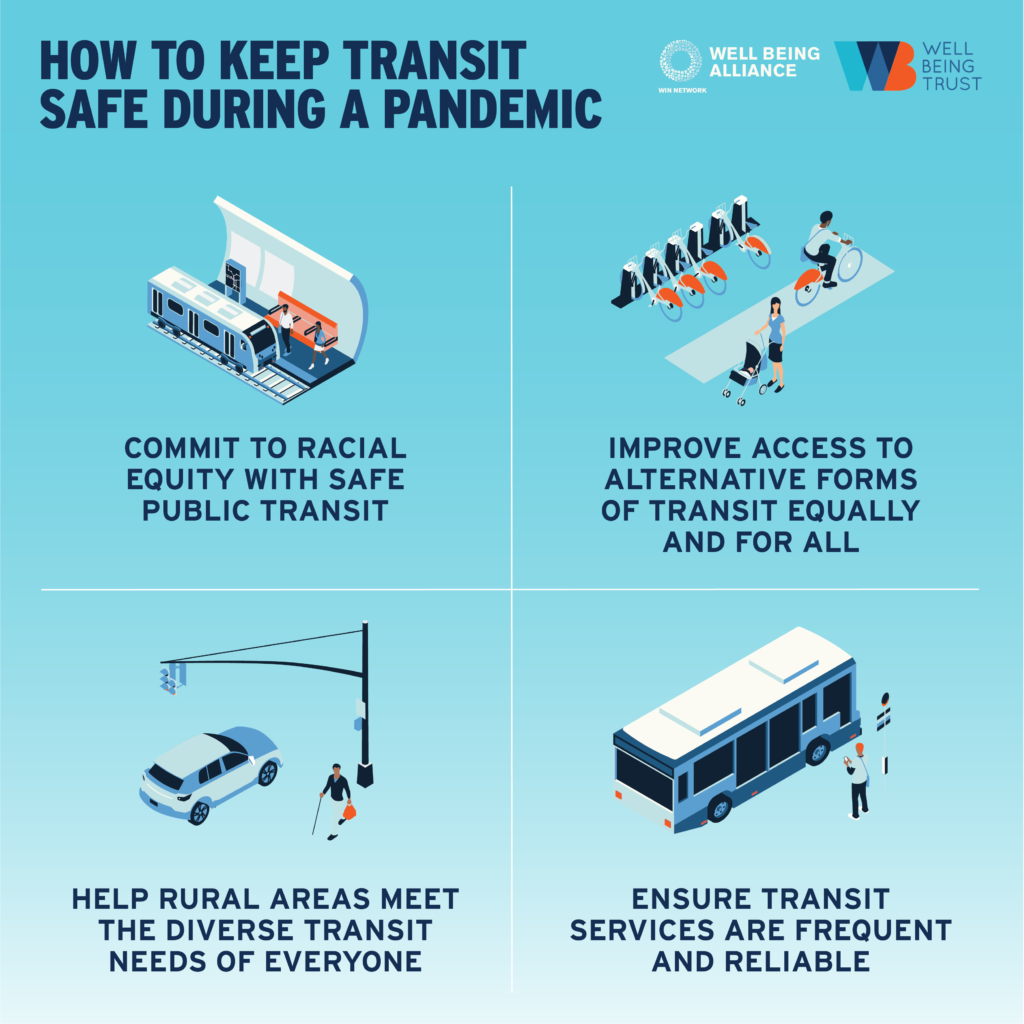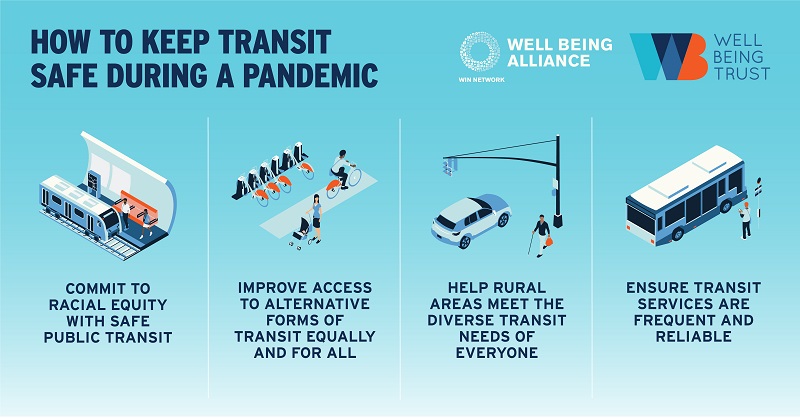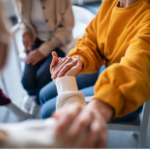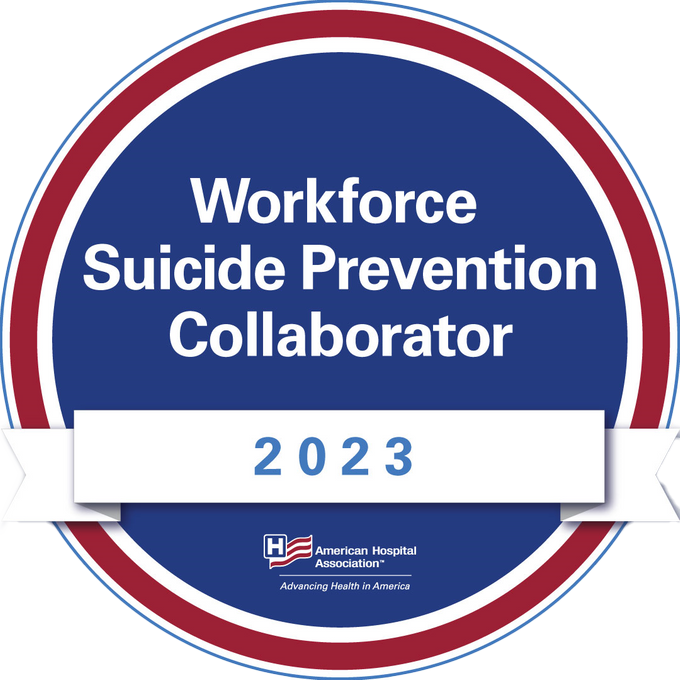Reimagining transportation to encourage social distancing
How we can ensure transit remains a safe and reliable option for all riders during the pandemic
Blog by Lisa Herron, Executive Fellow, Well Being Trust
Transportation plays a critical role in shaping community health. Even amid today’s pandemic, in which physical distancing guidelines are of the utmost importance to prevent the further spread of the virus, access to safe and reliable transportation is significant, especially to those who rely on it. Americans who are lower-income and people of color are more likely to rely on public transportation on a regular basis–including 2.8 million essential workers, as well as those who need public transit to access grocery stores, pharmacies, and other basic needs.
Safe transportation is also a reflection of a communities’ commitment to equity, given that essential workers are more likely to be Black and Latino and subsequently at higher risk of contracting and dying of COVID-19. Limiting crowding on transit and keeping transit service available is a prevention pathway. That said, recent news reports indicate transit riding has been relatively safe during these times—with no COVID clusters found on subways, trains, and buses.
Drops in ridership through March and April, will begin to increase as stay-at-home orders lift across the country. As people look to 
Members of the Well Being Alliance, including Transportation for America, TransitCenter, and Rails-to-Trails Conservancy have brought their solutions to the table to help protect constituents and encourage safe ridership. Solutions range from providing subsidies to transit services to rethinking transit frequency.
Here are three ways we can reimagine transportation to maintain its essential role in supporting families and workers, while also maintaining public health and safety through the pandemic:
Ensure transit services are frequent and reliable.
Ridership on public transportation plunged under shelter-in-place orders. In some places, such as Washington, D.C., 95% fewer riders were using public buses, trains and subways. In response, public transit agencies reduced routes and cut back on operating hours. But as people, slowly but surely, return to their normal lives and routines, ensuring bus and train services can prevent crowding — often caused by irregular schedules — will be critical to preventing further spread of the virus.
To do so, TransitCenter recommends transit agencies shift away from schedule-based dispatching — sticking to the times listed on published schedules — to a system that prioritizes even spacing between vehicles and prevents bunching and gapping from occurring along routes. This method, prioritizing regularity, is key to limiting crowding on transit. Real-time data, provided through automated vehicle location technology, available online or at transit stops can also help transit agencies provide riders with realistic transit schedules and better manage mid-route changes to maintain spacing between vehicles.
Improve access to other forms of alternative transit.
Buses and trains are not the only way to get around. Other forms of alternative transportation — such as walking, biking and ridesharing — are proving just as valuable in helping to reduce the risk of contact with COVID-19, and they should be promoted. For example, New York City-based nonprofit Transportation Alternatives launched a program called Bike Match in response to the pandemic, which connects people who wish to donate their unused bikes to others who don’t have or can’t afford a bike.
Rails-to-Trails Conservancy is working with other transportation partners on opening streets to pedestrians, bicyclists, wheelchairs and other human-centered mobility options. This means restricting motor vehicle access to underused streets, ensuring people are able to get around while maintaining social distance. Many cities are adopting such policies, including Boston, Minneapolis, and Oakland, California. Oakland has already closed more than 70 miles of roadway to cars and trucks to prioritize pedestrians. Please see Rails-to-Trails compendium search for a list of states and organizations adopting important policies.
These policies can and should be flexible to meet local needs, such as focusing closures on times when walk/bike demand are high (and/or vehicle demand low), or that exceptions can be made for emergency vehicles and public transit.
Employers could also play a role in protecting essential workers’ health by subsidizing ride-share bikes and electric scooters.
Subsidize rural transit and equip rural areas to design services to meet residents’ needs.
Although public transit is often thought of as a critical resource in urban communities, this essential service is equally important in rural communities, where people have to travel farther to access essential services and fulfill basic needs, such as groceries, schools and health care. As a result, these communities face a higher risk of being impacted by COVID-19. Transit agencies in rural areas — who were already tight on funding — have been hit hard by the pandemic, and operating transit in rural areas is more costly, particularly with demand-response transit, which allows riders to request pick-up and drop-off locations, as opposed to running on fixed routes. But according to recent American Community Survey data from the Census Bureau, more than one million rural households do not have access to a car, pointing to the necessity of rural transit services.
The needs of urban and rural America are not the same, and neither should their transit systems be. Smart Growth America advocates for additional funding to be allocated to rural areas in order to improve the transit that best serve their residents’ needs. For example, increasing the number of vehicles available for demand-response transit could ensure that more people will be able to travel to essential locations, while ensuring time to sanitize vehicles between trips. Subsidizing rural transit is a critical part of the solution to ensuring residents in rural areas continue to have access to affordable transportation.






